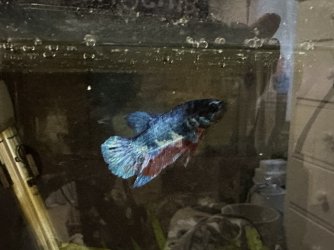alli789
New Member
My plakat betta has some new-ish ragged edges to his tail fin and a hole in the middle of his fin, so I'm suspecting fin rot. I've been through severe and stubborn fin rot before with my past betta, so I've gone through the motions. Ammonia and nitrites are zero, nitrates between 5-10ppm after 9 days with no water change. Live plants, 10 gallon tank, weekly 30% water changes with gravel vacuum. Trust me, I've checked everything. I'm currently trying a low dose of aquarium salt (1 Tb per 3 gallons) but it's been two weeks and there's been no change; the hole might have gotten a little bit bigger this week. So I'm thinking it's time to treat with an antibiotic. I used Maracyn 2 in the past but it seems impossible to find now, so I need to try something new.
What broad spectrum or gram-negative treating antibiotics have you had luck with for treating fin rot? I'm currently looking at Kanaplex, API Fin and Body Cure, or Polyguard. I'm considering Polyguard because it says it covers nearly all bases and I don't know for sure what the cause is. There's no discoloration or anything, just the ragged edges and hole. The fish is also still super active, hungry, and acting totally normal.
Recommendations appreciated!
What broad spectrum or gram-negative treating antibiotics have you had luck with for treating fin rot? I'm currently looking at Kanaplex, API Fin and Body Cure, or Polyguard. I'm considering Polyguard because it says it covers nearly all bases and I don't know for sure what the cause is. There's no discoloration or anything, just the ragged edges and hole. The fish is also still super active, hungry, and acting totally normal.
Recommendations appreciated!


